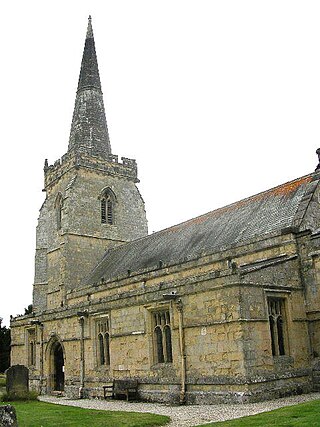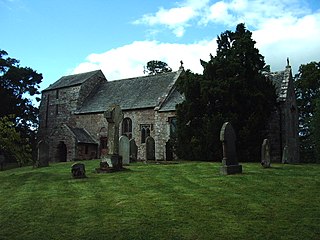
St Helen's Church is the parish church of Stillingfleet, in North Yorkshire, in England.

St Helen's Church is the parish church of Stillingfleet, in North Yorkshire, in England.
The church was originally built in about 1145, from which time the nave, chancel and south porch survive. [1] It is likely that this was the entirety of the church at the time; the Victoria County History states that "for its size it was notably well decorated". [2] In the 13th century, a north aisle and chapel dedicated to Saint Anne were added. The lowest stage of the tower also dates from this time. [1]
In 1336, the Moreby Chapel was added, and new windows were added to the chancel. In the 15th and 16th centuries, the upper parts of the tower were rebuilt, the chancel arch removed, the north aisle was heightened. Some of this work dates from about 1520, when bequests totalling £50 were made. However, by 1567, the chancel was in poor condition. Some work may have been done in the late 17th century, and the nave roof was rebuilt in 1828. [2] Between 1875 and 1884, [1] the church was restored by C. Hodgson Fowler, the east end was rebuilt, a gallery was added, and new pews were installed. [2] In 1966, the church was Grade I listed. [1]

The most noted feature of the church is its door, which is at least as old as the church, but generally thought to date from the 10th century, and to have been moved to the church when it was built. [3] Its ironwork includes the hinges, a cross, a ship, two figures, a tree, a horned figure, and a further figure on its own. In 1990, the door was taken to London, where it was restored by Plowden & Smith. [4] In 2002, it was returned to Stillingfleet, and rehung inside the church, with a new door constructed, with ironwork recalling that of the Saxon door. [5]
The church is built of Magnesian limestone. It has a three-bay nave and a two-bay chancel, with the tower at the west end. The tower has a single lancet window on the west side, and a mullioned window on the south. The top of the tower has battlements. [1]
On the south side is the main doorway, contemporary with the church, but moved in the 13th century, when St Anne's Chapel was added. The doorway has five orders of decoration. On the north side is the priest's doorway, which also has decorative mouldings and a plank door with decorative hinges. [1]
Inside the church, there is an effigy of a knight, dating from about 1337, and dedicated to Robert of Moreby. There is an alabaster monument to John Acklam, carved in 1613. One window in the chancel has glass dating from 1520 and restored in 1698, depicting the arms of Stillington impaling Bigod. Two chancel screens in the Moreby Chapel are said to have been made in 1877, from 17th-century woodwork. The Chapel of St Anne has panelling dating from about 1650. There are also an organ and three bells, two dating from 1626, and one from 1747. [2]

St Mary's Church is an Anglican parish church in the village of Newbold Astbury, Cheshire, England. It is recorded in the National Heritage List for England as a designated Grade I listed building, and its architecture has been praised by a number of writers.

St Mary's Church in Cheadle, Greater Manchester, England, is a Grade I listed building. It is an Anglican parish church in the diocese of Chester, the archdeaconry of Macclesfield and the deanery of Cheadle. Its benefice is united with that of St Cuthbert.

Horley is a village and civil parish in the north of Oxfordshire about 3 miles (5 km) north-west of Banbury.

St Kentigern's Church,, is in the village of Caldbeck, Cumbria, England. It is an active Anglican parish church in the deanery of Carlisle, the archdeaconry of Carlisle and the diocese of Carlisle. The church is recorded in the National Heritage List for England as a designated Grade I listed building. It is dedicated to Saint Kentigern, whose alternative name is Saint Mungo; hence the church's alternative title of Caldbeck, St Mungo.

St Peter's Church is a redundant Anglican church in the village of Wintringham, North Yorkshire, England. It is recorded in the National Heritage List for England as a designated Grade I listed building, and is under the care of the Churches Conservation Trust. The architectural historian Nikolaus Pevsner described the building as "the most rewarding church in the East Riding with an exceptional collection of furnishings".

St John's Church is a redundant Anglican church in the village of Duxford, Cambridgeshire, England. In 1967 it was recorded in the National Heritage List for England as a designated Grade I listed building, and is now vested in The Churches Conservation Trust. The church stands on the junction of St John's Street and Green Street and is open daily to visitors.

St James' Church is in the village of Great Ormside, Cumbria, England. It is an active Anglican parish church in the deanery of Appleby, the archdeaconry of Carlisle, and the diocese of Carlisle. The parish is united with nine other parishes and thirteen places of worship to form the Heart of Eden benefice. The church is recorded in the National Heritage List for England as a designated Grade I listed building. It stands on top of a circular mound overlooking the River Eden.

St Mary's Church is a redundant Anglican church in the village of Pitstone, Buckinghamshire, England. It is recorded in the National Heritage List for England as a designated Grade I listed building, and is under the care of the Churches Conservation Trust. The church stands to the southeast of the village, some 9 miles (14 km) east of Aylesbury.

St Peter's Church is a redundant Anglican church in Sandwich, Kent, England. It is recorded in the National Heritage List for England as a designated Grade I listed building, and is under the care of the Churches Conservation Trust.

The Church of St James the Less is in the village of Tatham, Lancashire, England. It is an active Anglican parish church in the deanery of Tunstall, the archdeaconry of Lancaster and the diocese of Blackburn. Its benefice is united with those of St Wilfrid, Melling, St John the Baptist, Tunstall, St Peter, Leck, the Good Shepherd, Lowgill, and Holy Trinity, Wray, to form the benefice of East Lonsdale. The church is recorded in the National Heritage List for England as a designated Grade II* listed building. It stands above the flood plain of the River Wenning.

St Michael's Church is in Church Lane, Aughton, Lancashire, England. It is an active Anglican parish church in the deanery of Ormskirk, the archdeaconry of Wigan & West Lancashire, and the diocese of Liverpool. Its benefice is united with that of Holy Trinity, Bickerstaffe. The church is recorded in the National Heritage List for England as a designated Grade I listed building.

St Mary's Church is in the town of Kirkby Lonsdale, Cumbria, England. It is an active Anglican parish church in the deanery of Kendal, the archdeaconry of Westmorland and Furness, and the diocese of Carlisle. Its benefice is united with those of six local churches to form the Kirkby Lonsdale Team Ministry. The church contains Norman architecture and is recorded in the National Heritage List for England as a designated Grade I listed building.

St Michael and All Angels Church is a parish church in Marden, Kent. It was begun circa 1200 and is a Grade I listed building.

Stubbekøbing Church is located in Stubbekøbing some 18 km (11 mi) northeast of Nørre Alslev on the Danish island of Falster. The basilical nave was built of limestone in the Late Romanesque period. Choir and tower are of brick, the choir built in Early Gothic style, tower and the northern chapels in the 15th century in Late Gothic style. In addition to its Renaissance altarpiece and pulpit, it has a variety of old frescos and wall decorations (1300–1500).

The Church of St John the Evangelist is a Grade I listed Church of England parish church dedicated to John the Evangelist, in Corby Glen, Lincolnshire, England. The church is 9 miles (14 km) south-east of Grantham, and in the South Kesteven Lincolnshire Vales. It is noted in particular for its 14th- and 15th-century medieval wall paintings.

The Church of St Mary the Virgin is a parish church of the Church of England in Baldock in Hertfordshire. Dedicated to the Virgin Mary, the original church on the site dated to about 1150 and was built by the Knights Templar before being largely rebuilt in about 1330 by the Knights Hospitaller. It is a Grade I listed building.

St James the Great Church is a Grade I listed Church of England parish church dedicated to James, son of Zebedee in Aslackby, Lincolnshire, England. The church is 7 miles (11 km) north from Bourne, and in the Aslackby and Laughton parish on the eastern edge the South Kesteven Lincolnshire Vales.

The Church of St Mary the Virgin in Pilton is the 13th-century Anglican parish church for the Pilton suburb of Barnstaple in Devon. It has been a Grade I listed building since 1951 and comes under the Diocese of Exeter.

St Mary's Church is an Anglican parish church in the English village of Welwick in the East Riding of Yorkshire. It is a Grade I listed building.

St Mary's Church is the parish church of Riccall, a village north of Selby in North Yorkshire, England.